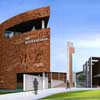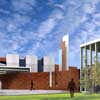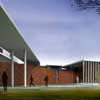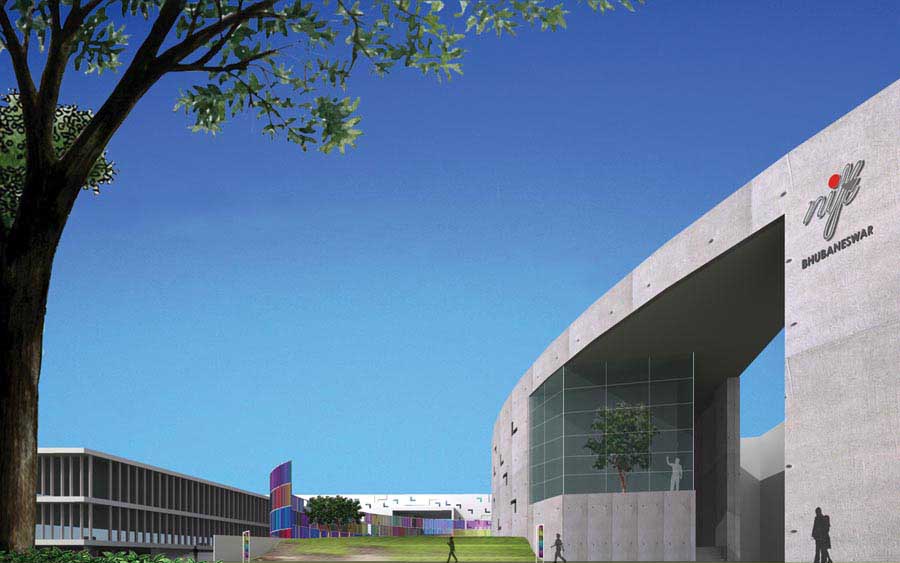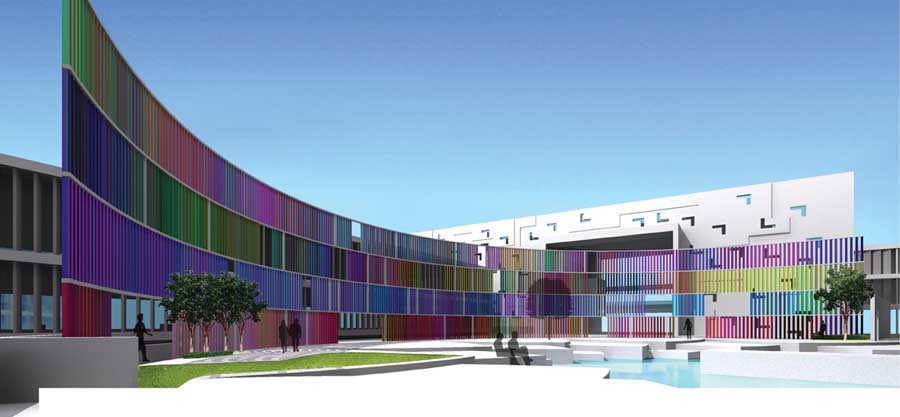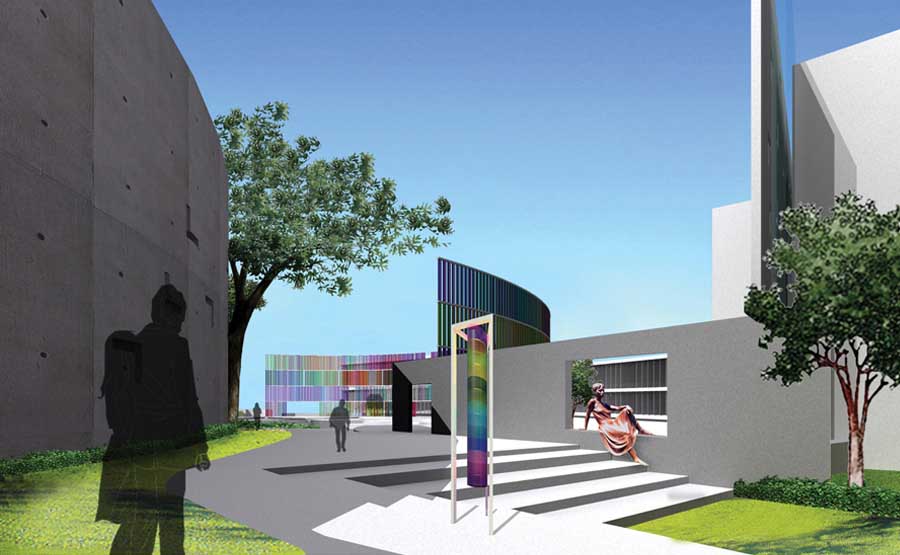The earlier standing advertisement only had positions for five schools. This one at http://www.iitbbs.ac.in/faculty-position.php includes positions for two new schools: School of Earth, Ocean and Climate Sciences and School of Minerals, Metallurgical and Materials Engineering. Earlier there were specific ads for a chair professor and professors position for those two new schools. I just found out that Prof. Subhasis Tripathy (on lien from IIT Kharagpur for two years) has joined as the professor to lead the School of Earth, Ocean and Climate Sciences at IIT Bhubaneswar.
STANDING ADVERTISEMENT FOR FACULTY POSITION
IIT Bhubaneswar invites applications for faculty positions at the level of Professor, Associate Professor, Assistant Professor and Assistant Professor (on contractual basis) in the following seven Schools:
Schools (Disciplines): School of Mechanical Sciences (Mechanical Engineering, Manufacturing Engineering and Materials), School of Electrical Sciences (Electrical Engineering, Electronics & T elecommunication Engineering, Computer Science & Engineering), School of Infrastructure (Civil Engineering), School of Basic Sciences (Physics, Chemistry, Mathematics and Bioscience), School of HSS & Management (English, Economics, Philosophy and Psychology), School of Earth Ocean and Climate Sciences (Earth Sciences and Climate Sciences) and School of Minerals, Metallurgical and Materials Engineering (Minerals Engineering, Metallurgical Engineering and Materials Engineering).
MINIMUM QUALIFICATION
Ph.D. with first class or equivalent in the preceding degree in appropriate branch with a very good academic record throughout and evidence of ability to pursue independent high quality research.
EXPERIENCE
Professor: A minimum of 10 years teaching / research / industrial experience of which at least 4 years should be at the level of Associate Professor in IITs, IISc Bangalore, IIMs, NITIE Mumbai and IISERs or at an equivalent level in any such other Indian or foreign institutions of comparable standards.
Associate Professor: At least 6 years teaching / research / industrial experience of which at least 3 years should be at the level of Assistant Professor, Senior Scientific Officer / Senior Design Engineer.
Assistant Professor: At least 3 years teaching / research / industrial experience excluding, however, the experience gained while pursuing Ph.D.
Assistant Professor (on contractual basis): May have less than 3 years teaching / research / industrial experience.
SCALE OF PAY:
| Position |
Pay Band |
Minimum Pay in Pay band |
Academic Grade Pay |
| Professor |
PB4: Rs. 37400 – Rs. 67000 |
Rs 48000 |
Rs. 10500 |
| Associate Professor |
PB4: Rs. 37400 – Rs. 67000 |
Rs 42800 |
Rs 9500 |
| Assistant Professor |
PB3: Rs. 15600 – Rs. 39100
On completion of 3 Yrs of service shall move to PB4: Rs. 37400 – Rs. 67000 |
Rs 30000 |
Rs 8000
Rs 9000
|
| Assistant Professor (on contractual basis) |
PB3: Rs. 15600 – Rs. 39100 |
Rs 20140 |
With less than or equal to one year experience: Rs.6000
With more than one year experience: Rs.7000
In the above cases experience will be counted excluding that gained while pursuing Ph.D. |
In addition to above pay, allowances as admissible to Central Government employees are applicable.
OTHER INCENTIVES
1. A cumulative Professional Development Allowance of Rs. 3 lakhs for every block period of 3 years on reimbursement basis to meet the expenses for attending international/national conferences, paying membership fees of professional bodies, covering book grant, paying telephone charges and meeting contingent expenses etc. as per Institute guidelines.
2. Initial seed grant up to Rs.5 lakhs for initiating research project in a chosen area.
3. Reimbursement of relocation charges at the time of joining up to a ceiling of Rs.
90,000/- as per Institute norm.
4. Honorarium of Rs. 15,000/- per month to the faculty members who have obtained
Bhatnagar Award OR are Fellows of at least two National Academies.
A faculty member is entitled for only one honorarium.
NOTES
• Reservation for SC/ST/OBC/PH as per Government of India rules.
• Minimum requirement of experience may be relaxed in respect of outstanding
candidates.
• Mere eligibility will not vest any right on any candidate for being called for interview.
The decision of the Institute in all matters of selection will be final.
• The Institute reserves the right to call only the requisite number of candidates for interview after shortlisting in terms of the candidates’ qualification, suitability and
experience.
• For the post of Assistant Professor the candidates should be preferably below 35 years
of age
• Canvassing in any manner would entail disqualification of the candidature.
NO INTERIM ENQUIRIES WILL BE ENTERTAINED.
HOW TO APPLY
Candidates possessing the requisite qualification and experience may submit their application in the prescribed form either in hard-copy or by e-mail to the Assistant Registrar (A&E), Indian Institute of Technology Bhubaneswar, Samantapuri, Bhubaneswar – 751013 (email: faculty.app@iitbbs.ac.in).
Application form can be downloaded from the Institute website (www.iitbbs.ac.in or www.iitbbs.gov.in).
Applicants desiring to apply for more than one School should send separate application for each School.
The candidates applying from Government Organizations or Public Sector Undertaking should have their applications duly forwarded by their present employer.
The candidates may apply any time throughout the year. The Institute will consider the applications at any date in the year received up to that date depending on its requirements and/or the quality of the applications.
Registrar
March 21st, 2011
Update: As per a report in Business Standard:
"the construction work for the hospital has been awarded to L&T, the medical college construction work is being done by Chennai-based Consolidated Construction Consortium Ltd."
Following is from a report in Times of India.
… In total, each AIIMS-like institution has been built at nearly Rs 847 crore, up from Rs 332 crore that was originally estimated.
… He added: "More than $2.5 billion will be spent in the next 2-3 years to establish six state-of-art tertiary care institutions modelled on the lines of our premier institute All India Institute of Medical Sciences in the under-developed and under-served regions of the country."
Around 94 eminent scientists, doctors and academicians have applied for the posts of directors in these six institutes. A health ministry’s search-and-selection panel is finalizing the names of six directors from these aspirants’ list. The colleges are located at Patna, Raipur, Bhopal, Bhubaneswar, Jodhpur and Rishikesh under the Pradhan Mantri Swasthya Suraksha Yojana (PMSSY).
"Constructing the medical colleges took 15-18 months. Civil work will end by August-September. There will be 600 additional MBBS seats. The hospitals will be ready next year. Each will have 960 beds, including 500 beds for the medical college hospital, 300 beds for speciality/super speciality and 100 beds for ICU/accident trauma,"an official said.
In the second phase of PMSSY, the government has also approved setting up of two more such institutions. Union health secretary K Chandramouli told TOI that "the present schedule is to admit MBBS students from 2012. The hospital will be ready a year later."
Following is from a PIB dated 16th March 2011.
The Minister also informed that nearly Rs 10,000 crores will be spent in the next 2-3 years to establish six state-of- art tertiary care institutions modelled on the lines of All India Institute of Medical Sciences in the under-developed and under-served regions of the country. Likewise, over 300 million US dollars are being invested in Government medical colleges for expanding medical seats and 250 million US dollars on establishing 250 nursing schools in the country in the same underserved areas so as to increase the overall availability of health personnel in these states. There is an urgent need for drawing up short term and long term plans to meet unmet requirement of health manpower at the grassroots level, he emphasized. It is for this reason that the Ministry of Health & Family Welfare has taken several path-breaking initiatives not only towards augmenting the requirements of rural health manpower, but also towards ‘capacity building’ for health professionals in the country. As a consequence of these measures, “I expect that within a short span of time an additional 10000 seats in post graduate medical courses will be created in just three years time – something that has not happened since independence”, he said. The challenge however is now to ensure that the desired quality of teaching and training is not compromised with in any manner, he cautioned. …
March 17th, 2011
Following is from PIB dated 16th March 2011.
The ESI Corporation has laid down norms for setting up of ESI hospitals. The ESI hospitals are sanctioned based on the request of the State Government and taking into consideration the requirement and norms laid down by the ESI Corporation. The ESI Corporation does not receive any budgetary support and, therefore, does not follow the Five Year Plan targets. It sets its own targets. The details of the ESI hospitals, as approved by the ESI Corporation, under construction are as under:
1. Baddi, Himachal Pradesh
2. Bhiwadi, Rajasthan
3. Manesar, Haryana
4. Peenya, Karnataka
5. Tirunelveli, Tamil Nadu
6. Hyderabad, Andhra Pradesh
Hospitals sanctioned and proposed to be set up, as approved by the ESI Corporation, are as under:
1. Haridwar, Uttrakhand
2. Udham Singh Nagar, Uttrakhand
3. Ankleshwar, Gujarat
4. Udaipur, Rajasthan
5. Tirupur, Tamil Nadu
6. Lalru, SAS Nagar, Punjab
7. Angul, Orissa
8. Duburi, Jajpur District Orissa
9. Bhilai, Chhattisgarh
10. Korba, Chhattisgarh
Details of Medical Education Projects sanctioned (State-wise) are given as under:
|
Sl.
No.
|
State
|
Institutions
|
|
|
|
PGIMSR
|
Medical
College
|
Dental
College
|
Nursing
College
|
Para-Medical
Training
Institute
|
|
1.
|
Andhra Pradesh
|
Hyderabad
|
Hyderabad
|
Hyderabad
|
–
|
–
|
|
2.
|
Bihar
|
–
|
Patna
(Green Field
Project)
|
–
|
–
|
–
|
|
3.
|
Gujarat
|
Ahmedabad
|
Naroda
|
Naroda
|
–
|
–
|
|
4.
|
Haryana
|
–
|
Faridabad
|
–
|
–
|
–
|
|
5.
|
Himachal
Pradesh
|
–
|
Mandi
(Green Field
Project)
|
–
|
–
|
–
|
|
6.
|
Karnataka
|
Rajaji Nagar,
Bangalore
|
Bangalore
|
Gulbarga
(Green Field
Project)
|
Bangalore
|
Gulbarga
(Green Field
Project)
|
|
Indira Nagar,
Bangalore
|
Gulbarga
(Green Field
Project)
|
–
|
Gulbarga
(Green Field
Project)
|
–
|
|
7.
|
Kerala
|
–
|
Kollam
|
Kollam
|
–
|
–
|
|
8.
|
Maharashtra
|
Mulund
|
Mulund
|
Navi Mumbai
|
–
|
–
|
|
Andheri (E),
Mumbai
|
–
|
–
|
–
|
–
|
|
Parel, Mumbai
|
–
|
–
|
–
|
–
|
|
9.
|
Madhya
Pradesh
|
–
|
Indore
|
Indore
|
–
|
–
|
|
10.
|
New Delhi
|
Basaidarapur
|
Basaidarapur
|
Rohini
|
–
|
–
|
|
11.
|
Orissa
|
–
|
Bhubaneswar
|
–
|
–
|
–
|
|
12.
|
Punjab
|
–
|
–
|
Ludhiana
(Green Field
Project)
|
–
|
–
|
|
13.
|
Rajasthan
|
–
|
Alwar
|
–
|
–
|
–
|
|
14.
|
Tamil Nadu
|
K.K. Nagar,
Chennai
|
Chennai
|
–
|
–
|
–
|
|
Ayanavaram,
Chennai
|
Coimbatore
|
–
|
–
|
–
|
|
15.
|
Uttar Pradesh
|
–
|
–
|
Kanpur
|
–
|
–
|
|
16.
|
Uttarakhand
|
–
|
Haridwar
(Green Field
Project)
|
–
|
–
|
–
|
|
17.
|
West Bengal
|
Joka, Kolkata
|
Kolkata
|
Kolkata
|
–
|
–
|
|
Manicktala,
Kolakata
|
Baltikuri
|
–
|
–
|
–
|
| |
|
|
|
|
|
|
|
At present, no project has been implemented under Public Private Partnership (PPP) mode.
This information was given by Shri Mallikarjun Kharge, Minister for Labour and Employment in a written reply to a question in the Rajya Sabha today.
YSK: PM
March 17th, 2011
The following is from http://www.iitlc.org/INDIAN INSTITUTE OF TECHNOLOGY BHUBANESWAR.pdf .
INDIAN INSTITUTE OF TECHNOLOGY BHUBANESWAR
To meet the increasing demand for quality technical education in the country, eight new IITs have
been established by the Government of India and IIT Bhubaneswar is the first amongst these to
become operational.
The Institute began its journey from the campus of IIT Kharagpur, the mentor Institute of IIT
Bhubaneswar on 22 nd July 2008. The Institute started operating from its temporary campuses in the
heart of the city of Bhubaneswar from 22 nd July 2009 with 228 undergraduate students in the
disciplines of Civil, Electrical and Mechanical Engineering and 6 Ph.D. scholars. Currently annual
UG intake capacity in each discipline is 40. Admission to Ph.D. programme is carried out in every
semester. The Institute envisages a growth path of 5000 students (UG, PG and Research) with 500
faculties in a decade.
For the permanent campus of IIT Bhubaneswar the Government of Orissa has allotted 936 acres of
land at Argul near Bhubaneswar, which is only 14 km from the Bhubaneswar airport. The architect
and project management consultant has already been appointed to put the project on fast track.
The Institute was born with the concept of schools rather than departments with its focus on
nourishing interdisciplinary environment. The existing schools are:
- School of Basic Sciences (Physics, Chemistry, Bioscience, Mathematics)
- School of Humanities, Social Sciences and Management
- School of Mechanical Sciences (Mechanical, Manufacturing and Industrial Engineering,Aerospace Engineering)
- School of Infrastructure (Civil Engineering, Architecture, Urban design, Town Planning,Traffic and Transportation Engineering)
- School of Electrical Sciences (Electrical Engineering, Electronics & CommunicationEngineering, Computer Science and Engineering, Energy Engineering, Learning Sciences,Instrumentation)
The following schools are proposed to be set up in near future:
- School of Minerals and Materials Engineering – Materials, Metallurgy, Mining (relevant to the Rich resources of metals and minerals in the region)
- School of Earth, Ocean and Climate Sciences (Relevant to the region keeping in view the vastcoast line, rich biodiversity, need for disaster management and mitigation arising out of flood,cyclone etc)
- School of Chemical Sciences (Chemical, biochemical, biomedical, biotechnology)
- School of Design and Creative Arts
As a part of the School of Earth Ocean and Climate Sciences, the Institute has already planned to set up an Innovative Centre for Climate Change near the coast line of Orissa to study various aspects of climate change such as rise in sea level in the Bay of Bengal, effect of climate change on the marine life, health of the people in this region, disaster mitigation and management etc. Government of Orissa has already allotted nearly 100 acres of land on sea coast near Puri – Konark stretch and Government of India has agreed to support in creating the Centre.
The Institute has already started research and consultancy projects sponsored by DST, CSIR, DRDO and other funding agencies of the Government of India. With a view to significantly enhancing the activities in this direction, the faculty members are in the process of submitting large number of project proposals to government agencies and private sector industries. The Institute proposes to remain focused in the following broad areas for its research and development activities:
- Alternative Energy
- Bioscience and Bioengineering
- Environment and Climate Science
- Manufacturing
- Minerals and Materials Sciences
A Science Park shall be an integral part of the growth plan of IIT Bhubaneswar.
I knew about the Marine campus plans and request for land, but did not know that the government of Orissa has already allotted land for it and the government of India has agreed to support it. This is great news.
This means, in addition to its regular progress, IIT Bhubaneswar has been able to make progress in two new initiatives:
- A new School of Minerals and Materials Engineering that is helped by a 3 crore sponsored Chair by a private company. (See here and here.)
- A new School of Earth, Ocean and Climate Sciences with its own 100 acre campus near the ocean. (See here, here and here.)
Now if someone or some company or some MP can donate an initial amount (say 3-5 crores) for the other two proposed schools (School of Chemical Sciences and School of Design and Arts) then the establishment of those two can also be sped up. Note that a School of Design and Arts is almost like, or could be even better than, a National Institute of Design. In this earlier posting corporate partnership in establishing these schools is mentioned. Some initial steps towards establishing a School of Design has been made and mentioned here. I especially like the following quote in that report.
“We want IIT-Bhubaneswar to excel in product design and creation especially in auto and manufacturing sector,” the director said.
If IIT Bhubaneswar is able to have this school and is able to attract auto and other manufacturing companies, that would be wonderful.
March 16th, 2011
The following is from http://www.iitbbs.ac.in/pdf/MGM%20Chair%20Professor.pdf.
A Chair entitled “MGM Chair Professor” in Minerals, Metallurgical and Materials Engineering has been created in IIT Bhubaneswar with a generous endowment of `3 crores from MGM Minerals Limited, Bhubaneswar, Odisha as a measure of the Institute’s firm step towards a meaningful sustainable public private partnership.
The main objective of this Chair-Professor, as a full time faculty of IIT Bhubaneswar, will be to promote teaching and research in Minerals, Metallurgical and Materials Engineering with general activities and responsibilities as follows:
1. To play a leading role in the new School of Minerals, Metallurgical and Materials Sciences in IIT Bhubaneswar, and steering it towards achieving excellence in research and education.
2. To develop R&D programme relevant to the needs of MGM and other organizations in the related areas.
3. To develop and participate in the academic programmes of the Institute and coordinate research programmes funded by various agencies in the stated and related sector.
4. To initiate and develop student awareness programmes relevant to the needs of Minerals, Metallurgical and Materials Sciences in the country in general and in the State of Odisha in particular.
The tenure for appointment to the Chair shall normally be duration based. The incumbent will enjoy remuneration commensurate with experience and may be at the highest level for a Professor in IIT. The position carries supports in terms of free accommodation, research personnel, secretarial assistance, national and international travel and contingency expenses.
The institute is earnestly in search of an eminent academician/industry/R & D person who can occupy this prestigious position.
An accomplished motivated personality willing to take up this challenging and rewarding opportunity in a city supportive environment may send urgently his/her CV either in hard copy or by e-mail to the Director, IIT Bhubaneswar, Samantapuri, Bhubaneswar-751013, India (e-mail: director@iitbbs.ac.in).
Those who submitted their CVs against our earlier advertisement dated 15.09.2010 need not to apply. However, they are welcome to submit their update CVs if they so desires.
Advt. No.: R/1/2011, Dated:10.02.2011
March 16th, 2011
Following is from http://www.e-architect.co.uk/india/imi_campus_bhubaneswar.htm.
Architects : ADS Designs Pvt. Ltd.
When asked to design the IMI campus at Bhubaneswar, Orissa, we decided at first to learn the ‘City of Temples’, to let it speak to us. And….. it spoke like never before!
The temples with their rich architecture, atypical to any other in India, and sanctity had us overwhelmed.
The primitive rock cut cave architecture took us back in time.
The sculptural motifs left us breathless with their majesty, beauty and attention to detail.
The gardens, statues and fountains beckoned to us invitingly.
We took solace from the heat under extended roofs and traditional courtyards.
We found an architecture which had risen from the native soil – sacred and pure.
We found one of those rare places where tradition matches its steps with modernity, where culture and technology flourish together, where the glorious past is preserved and an illustrious future is in the making.
We finally understood what the city was trying to tell us.
The challenge lay in fusing the rich heritage and traditional elements in a modern setting.
For the purpose
The site is located in an extreme tropical climate on the outskirts of Bhubaneswar, about 14 kms from the city centre. The campus is to be built in three phases. The planning is done such that phase II & III construction, will not interfere with the daily happenings of the institute or residential facilities.
The site was broadly zoned according to site constraints and function, allowing for easy vehicular movement and short distance pedestrian movement. The academic block is placed between the student hostels and faculty residences acting as a buffer between them as well as making it easily accessible to both areas.
Keeping in mind the extreme summer conditions, the structures have been designed and oriented on site to minimize heat gain and reduce the use of electromechanical energy.
Interactive zones where students can spill out, unwind, celebrate or just be inspired are a very essential part of campus design. The main interactive zone has been designed as a central plaza of the academic block. A shaded walkway connects the plaza to the hostels, creating a strong visual link between the two. Other smaller zones have been designed at nodal points.
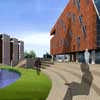


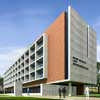
For the city
Although the design of the institute is very modern a conscious effort has been made to fuse into the concept some of the local influences. The curved façade of the library building in the academic block will have sculptures, replicated from Khandagiri caves, in stone embedded into the façade. As one views the academic block, one sees a modern design reinforced with the traditional. The beauty of the sculptures will leave the viewer speechless as one is reminded of the rich culture and history of the state.
The traditional courtyard here is in the form of a central stepped plaza, designed using solid laterite blocks, locally available in Orissa, which leads to a water body. Keeping the climatic factors in mind, the central water court acts as a natural exhaust cooling the air passing over it making the middle court a solace in the hot summer.
Large overhanging roofs, pergolas, colonnades are some of the traditional elements which have been used in the design.
A combination of brick cladding and painted surfaces have been used throughout the campus, giving it a very earthy and sobering feel especially in the summer.
A strong vertical axis is created in the form of a tower as a feature element, with a visibility from 3kms away, making the campus a landmark in the surrounding areas.
This design is a confluence of the traditional with the modern, where we allow the past to catch up with us, remind us where we come from, while taking a leap into the future.
As famous architect Frank O. Gehry said ‘Architecture should speak for its time and place, but yearn for timelessness’, we attempt to do just that.
IMI Campus Bhubaneswar images / information from ADS Designs Pvt. Ltd.
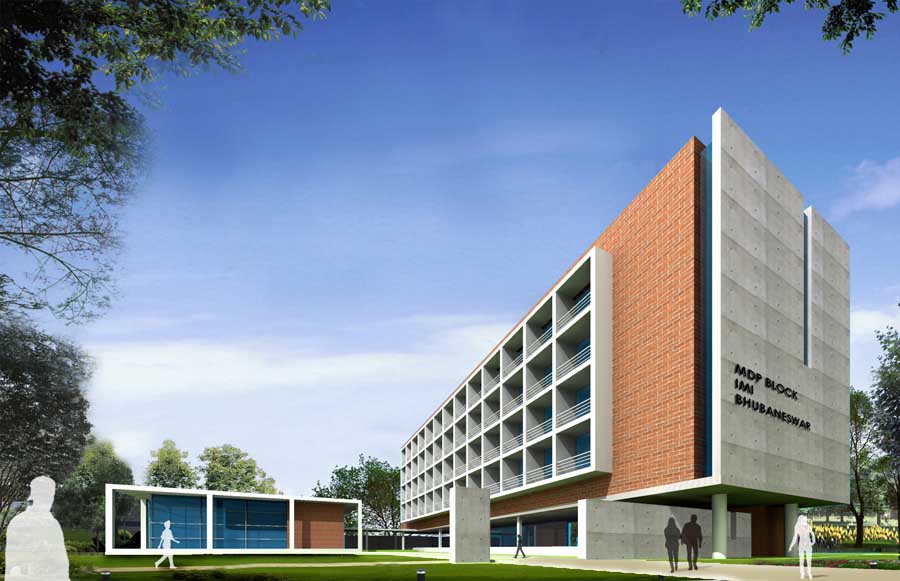
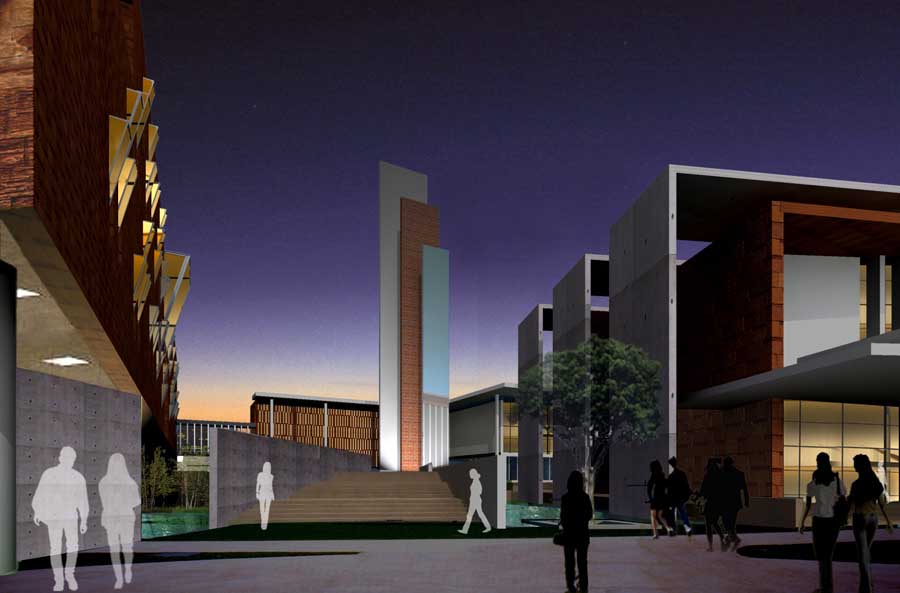
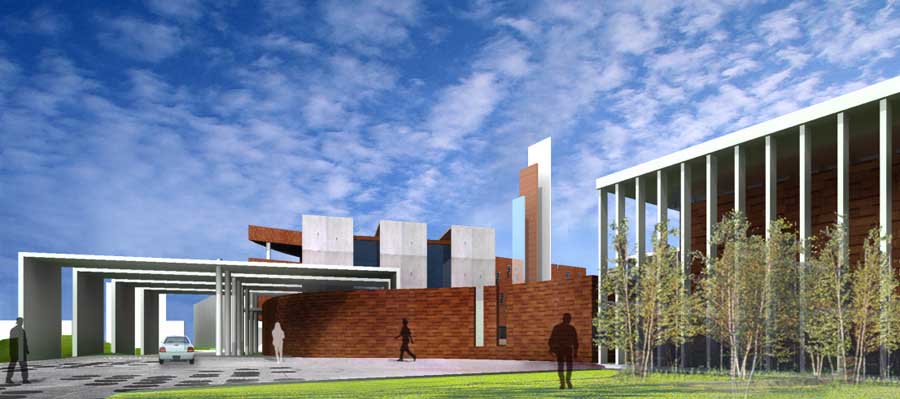
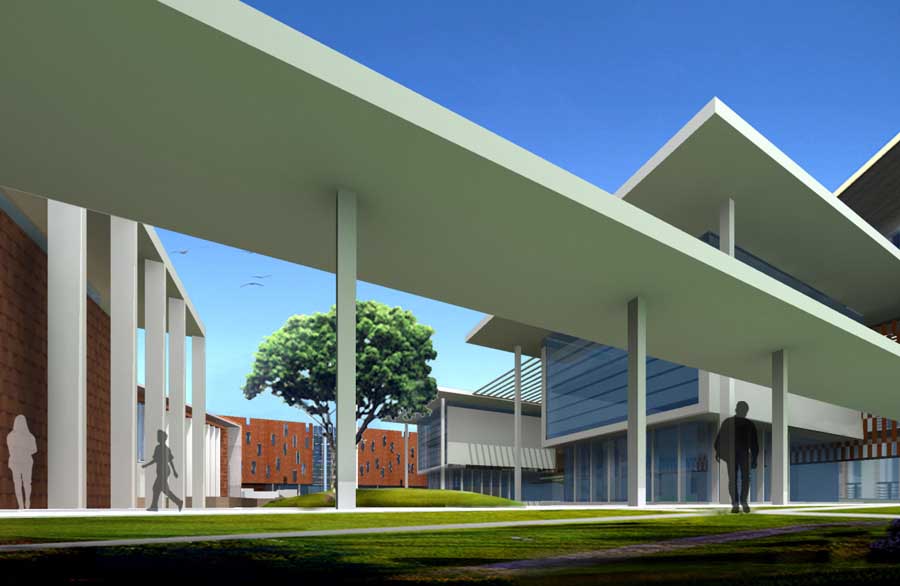
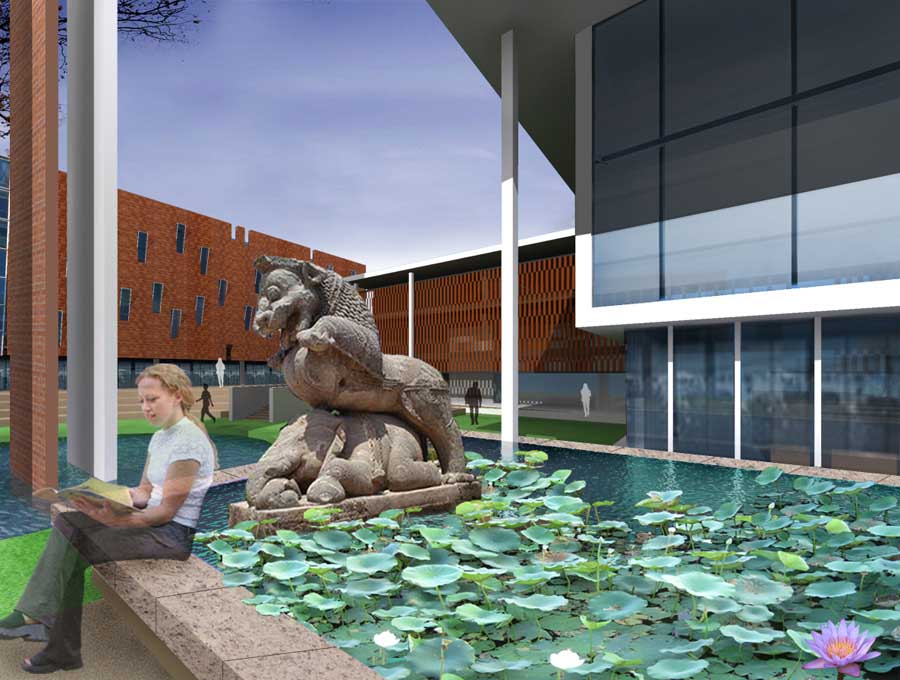
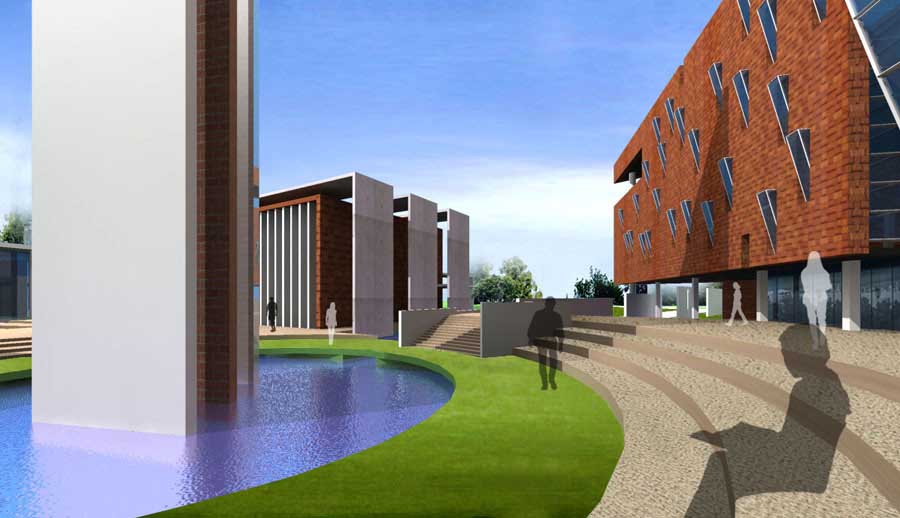
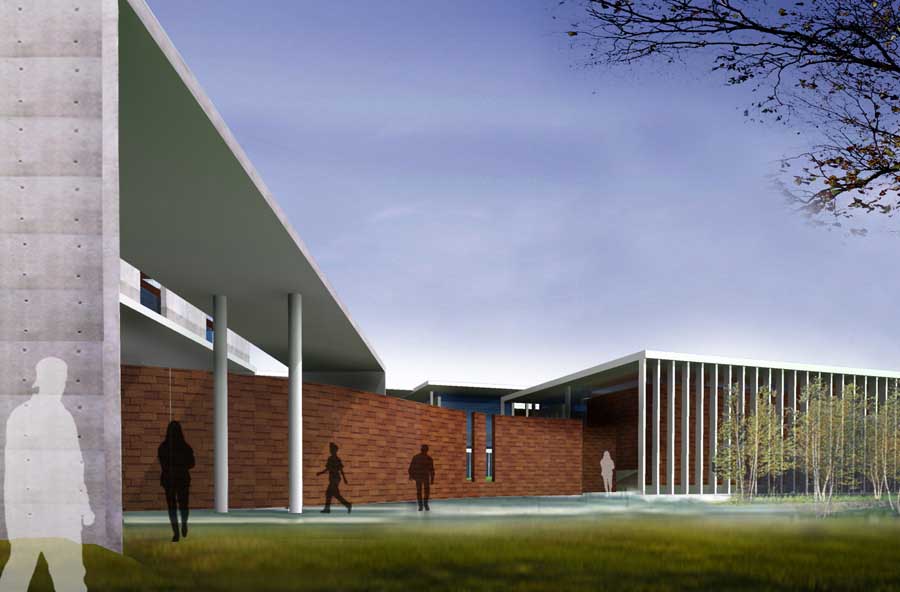
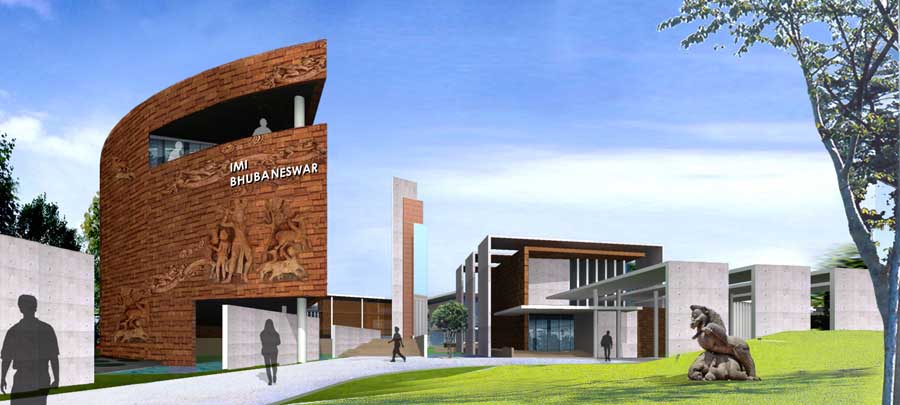
March 15th, 2011
Following is from http://www.e-architect.co.uk/india/nift_campus_bhubaneswar.htm.
‘Fashion is architecture: it is a matter of proportions’ said Coco Chanel, and rightly so. So why not let each be the inspiration for the other!
Orissa, a state widely known for its opulent cultural heritage and rich architecture has a history atypical from that of the northern plains. Unlike other parts of India, tribal customs and traditions have played a significant role in shaping the heritage of the state.
The unique and beautiful appliqué artwork of Pipili; silver filigree ornamental works and patta chitras; and tie and dye and Sambalpuri textiles in all its artistic grandeur awakens the imagination of creative minds.
An institute designed for budding designers and then the maestro, are the inner soul of the complex in very much the same way as the rich culture of Orissa is its inner soul.
The inner soul needs a shell. Shell and soul are interdependent and independent, belonging to each other and to themselves.
Here, the built form developed from climatic factors and conceptualized by elements of the crafts and nature, forms a shell for its soul providing them with spaces to imagine and innovate or simply to inspire.
REALITY
The site is located an uncongested area of Bhubaneswar. The architecture of Bhubaneswar is one of indoor and outdoor spaces merging into each other, the use of which is influenced by climate and season. It is an architecture which has risen from native soil-sacred and pure.
A simple yet modern architecture vocabulary has been adopted. The traditional courtyard here is in the form of a central stepped plaza, interspersed with trees and green patches, which leads to a water body. Keeping all climatic factors in mind, the central lotus water court acts as a natural exhaust, cooling the air passing over it, making the middle court a solace in the hot summer.
Designers dare to dream, to imagine, innovate and create that which is used, seen and felt by all. Someone once said “its not what you look at that matters, its what you see” and feel.
Dieter Rams rightly said:
“Good design is innovative.
Good design makes a product useful.
Good design is aesthetic.
Good design makes a product understandable.
Good design is unobtrusive.
Good design is honest.
Good design is long-lasting.
Good design is thorough down to the last detail.
Good design is environmentally friendly.
Good design is as little design as possible.”
We dream big and beyond the realms of imagination to create the unique. When soul and shell unite the destiny is ‘creation’.
Let us all dare to dream…
National Institute of Fashion Technology Campus Bhubaneswar images / information from Abin Design Studio
March 15th, 2011
The following is compiled from http://www.iiit-bh.ac.in/faculty/faculty-list and http://www.iiit-bh.ac.in/downloads/AdmissionBrochure2011.pdf?attredirects=0&d=1.
Computer Science:
- Dr. Gopal Krishna Nayak, B. Tech (IIT Kharagpur), PGDM (IIM Bangalore), Ph.D. (IIT Kharagpur), Professor & Director
- Mr. Ajit Kumar Das, B. Tech (IIT Kharagpur), M. Tech (UU), Ph.D. Continuing (UU), Professor & Dean
- Dr. Rakesh Chandra Balabantaray, M. Tech (UU), Ph. D. (UU), Assistant Professor
- Dr. Anjali Mohapatra, M. Tech. (UU), Ph. D. (UU), Assistant Professor
- Ms Puspanjali Mohapatra, M. Tech.(UU), Lecturer
- Mr. Muktikanta Sahu, M. Tech. (BPUT), Lecturer
- Dr. Debasish Jena, BE, M.Tech.(UU),Ph.D.(NIT, Rourkela), Assistant Professor
- Mr. Alok Chakrabarty , Ph.D. thesis submitted (Assam Univerisity), Lecturer
- Dr. Hemanta Kumar Pati , Ph.D. (IIT Kharagpur), Assistant Professor
- Mr. Suvendu Rup ,B.E(UU) , M.Tech.(Jadavpur University), Ph.D. continuing (NIT Rourkela), Lecturer
- Dr. Sudarsan Padhy, Ph.D, Emeritus Professor (Retired from Utkal University)
- Dr. Shakti Ranjan Mohapatra, Ph.D, Visiting Faculty, from CITE Bhubaneswar
- Dr. Ajit Nayak, Ph.D, Visiting Faculty, from ITER, SOA University Bhubaneswar
Electrical Engineering:
- Ms. Usharani Rout, M. Tech.(BIT, Mesra), Lecturer
- Mr. Tapas Kumar Panigrahi , M. Tech.(Bengal Engineering College), Senior Lecturer
- Ms. Umamani Subudhi , M.Tech.(UCE, Burla), Lecturer
Electronics:
- Mr. Harish Kumar Sahoo ,M.Tech.(NIT,Rourkela),Ph.D. continuing (Sambalpur University), Senior Lecturer
- Mr. Ratnakar Dash , M. Tech.(UCE, Burla), Ph.D.continuing (NIT, Rourkela), Lecturer
- Mr. Tapas Patra, Visiting Faculty, From CET Bhubaneswar
Mechanical Engineering:
- Mr. Bamadev Sahoo, M. Tech. (IIT Kharagpur), Senior Lecturer
- Mr. Biranchi Narayan Padhi , M. Tech.(UCE, Burla), Ph.D. continuing (NIT Rourkela), Senior Lecturer
- Dr. L. N. Panda, Ph.D, Visiting Faculty, From CET Bhubaneswar
- Dr. P. K. Satapathy, Ph.D, Visiting Faculty, From CET Bhubaneswar
Physics:
- Dr. Monalisa Ray, M.Phil., Ph.D.(UU), Senior Lecturer
- Dr. Biswajit Pradhan, Ph.D.(IIT Bombay), Lecturer
- Mr. R. K. Parida, Visiting Faculty, From ITER, SOA University
Chemistry:
- Dr. Satyanarayan Pal, Ph.D.(CU, Hyderabad), Senior Lecturer
- Dr. Hiranmayee Satapathy, Ph.D.(IIT Kharagpur), Lecturer
Mathematics:
- Dr. Rupaj Kumar Nayak, Ph.D.(UU), Assistant Professor
- Dr. Manas Ranjan Tripathy , Ph.D .(IIT Kharagpur), Lecturer
Humanities:
- Ms. Lipika Das, Lecturer, M. A., M.Phil., Ph.D.continuing (UU) – Communicative English, Lecturer
- Dr. Tanutrushna Panigrahi, Ph. D. (Berhampur University) – Communicative English, Senior Lecturer
March 5th, 2011
Following is from http://www.pib.nic.in/newsite/erelease.aspx?relid=70461.
The scheme of ‘Centres of Excellence in Polymer Technology’ aims at setting up of Centers of Excellence (COE) in existing educational and research institutions working in the field of polymers. It is expected that each Centre of Excellence (COE) will emerge as an internationally recognized Centre for the analysis and dissemination of existing global knowledge in the chosen fields. Detailed proposals received from the Institutions have been evaluated by an expert Panel for finalizing the names of institutions as Centres of Excellence during the 11th Plan period. Two fully functional Centres of Excellences (COEs) are to be established over a period of three years.
The campaign against plastic is restricted to plastic carry bags and their indiscriminate littering. The aim of setting up Centres of Excellence, inter alia, includes developing bio-polymers and bio-degradable polymers and innovative recycling process technology which may ultimately result in developing strategies to address such issues.
This information was given by the Minister of State for Chemicals and Fertilizers Shri Srikant Kumar Jena in a written reply in the Lok Sabha today.
DNM/PKM/SB
Perhaps one of these centers of excellence will be in Odisha as the CIPET campuses in Odisha have good research programs in polymer technology and it has the LARPM (Laboratory for advanced research in polymeric materials).
March 4th, 2011
Following are excerpts from an article in Frontline.
THE Siksha ‘O’ Anusandhan University in Bhubaneswar, a deemed university under Section 3 of the University Grants Commission Act, 1956, is fast developing as one of Orissa’s foremost educational hub. It started as a small venture in 1996 when the visionary educationist Dr Manojranjan Nayak set up the Institute of Technical Education and Research (ITER) with 118 students. Gradually, institutes offering courses such as management, medicine, dental sciences, nursing, pharmaceutical science, biotechnology, hotel management and law were set up.
With over 7,000 students, the ITER is today one of the highly-ranked engineering colleges in the eastern region. The university has been awarded ‘A’ grade by the National Assessment and Accreditation Council (NAAC) for five years from September 2009. All its institutes are housed on four campuses spread across 120-odd acres.
… The Institute of Medical Sciences has a 750-bed state-of-the-art hospital attached to it, which does not charge any consultation fee and has been endeavouring to provide quality health care facilities.
The latest addition to the university is the SOA National Institute of Law. The institute will start functioning from the academic year 2011-12 and offer a five-year integrated course in law in three different streams: BA LLB; BSc LLB; and BBA LLB. There will also be LLM and PhD programmes….
I am appreciative of SOA University’s contribution to education in Odisha, but the above article sounds too much like an ad and for that reason may not impress its readers.
February 22nd, 2011
NIFT (National Institute of Fashion Technology) currently has 15 campuses across the country in Bangalore, Bhopal, Bhubaneswar, Chennai, Delhi, Gandhinagar, Hyderabad, Jodhpur, Kangra, Kannur, Kolkata, Mumbai, Patna, Raebareli and Shillong. It opened its Bhubaneswar campus in 2010. Its Bhubaneswar campus home page is at http://www.nift.ac.in/bhubaneswar/index.html. Following is from that page.
The Bhubaneswar center is one of the latest additions to the existing countrywide gamut of NIFT. IT started functioning from June 2010 from its transit campus situated in Centurion Institute of Technology, near HP Gas Plant, Bhubaneswar.
The present campus is located within 1.5 KM from Khurdha railway station, 20 KM from Bhubaneswar railway station and 18 KM from Bhubaneswar airport. It is well connected to every part of the city through city bus and autorikshaws. Security is of prime importance in the institute, which is also a strictly non smoking zone.
The course being offered at the institute at present, include specialization in two disciplines, Bachelor of Design in Textile Design and Master of Fashion Management Studies. The institute boasts of eminent and experienced faculty to facilitate quality education from the very commencement of the center.
February 15th, 2011
The following is obtained from pages 15 and 16 of http://prsindia.org/uploads/media/Institutes%20of%20technology/SCR%20Institue%20of%20Technology%20Bill%202010.pdf.
| IIT |
Sanctioned Faculty Strength |
In Position |
Vacancies |
| Bombay |
637 |
491 |
146 |
| Delhi |
578 |
416 |
162 |
| Kanpur |
484 |
349 |
135 |
| Kharagpur |
870 |
530 |
340 |
| Madras |
566 |
449 |
117 |
| Guwahati |
340 |
260 |
80 |
| Roorkee |
577 |
378 |
199 |
| Bhubaneswar |
90 |
42 |
48 |
| Gandhinagar |
90 |
44 |
46 |
| Hyderabad |
90 |
46 |
44 |
| Indore |
60 |
30 |
30 |
| Jodhpur |
90 |
20 |
70 |
| Mandi |
60 |
16 |
44 |
| Patna |
90 |
44 |
46 |
| Ropar |
90 |
33 |
57 |
Note: The vacancy numbers for the new IITs should be discounted by 30 each as between the time the last 30 faculty lines were sanctioned and August there was not enough time to recruit against those sanctioned numbers.
February 14th, 2011
Update: Following is an excerpt from a Business Standard article dated Dec 13 2010.
Bala V Balachandran, founder & dean of Great Lakes Institute of Management in Chennai, is in talks with Tata Foundation and Pirojsha Godrej Foundation to sell nearly 51 per cent stake in his institute.
“I have 90 per cent stake in my institute. I have decided to give the ownership to somebody who can give me some money to expand. I may offload as much as 51 per cent. The valuation of the institute would be around Rs 220 crore,” Balachandran told Business Standard on the sidelines of an event in Mumbai.
… Great Lakes also plans to open campuses in Gurgaon and Bhubaneswar. While it has bought some land in Gurgaon, the Orissa government has leased it 100 acres of land for 99 years.
The Gurgaon campus will require around 50 crore to set up and the Orissa campus would be set up at a cost of Rs 100 crore.
Following is from a report in http://www.tathya.in/news/story.asp?sno=4966.
… Mr.Patnaik met Padmashree Prof. Balachandran , Professor of the Kellogg Institute of Management, USA here on 7 February.
After setting up the Indian School of Business, Hyderabad, along with some like-minded people, he started his Great Lakes Institute of Management, Chennai.
Now Prof. Balachandran has expressed his interest to set up UoCE near the Capital City.
… Hara Prasad Das, State President of the Infinity Education Foundation (IEF), Prasanta Kumar Mishra and Priyadarshi Mishra were present in the meeting.
IEF has given the proposal and has requested the Collector Khurda to provide land measuring an area of 88 acres for the university, which needs at least 100 acres.
Prof. Balachandran said that the UoCE would endeavour to create a well- rounded corporate manager, who will have solid foundation in basic disciplines such as Economics, Mathematics, Social Science and Business Communications.
The University will have School of Technology, School of Business, School of Law and School of Advanced Studies.
Chief Minister asked Mr.Mishra, Minister Higher Education to study the proposal and he promised to extend all out support for the same, said an official.
UoCE will have top collaborative universities including Carnegie Mellon University, MIT, IIT, Harvard Business School, Kellogg School of Management, Harvard Law School, Yale Law School and several others.
IEF has also planned for setting up of a Knowledge City to optimise high quality world class infrastructure and facilities for multiple universities located in a cluster within one campus.
They require 1000 acres of land for the purpose and investment will go up to Rs.10,000 crore, said Mr.Mishra, Minister Higher Education.
Some behind the scenes story and lesson: Dr. Prasanta Mishra mentioned above has played a significant role in partnering with Prof. Balachandran. Dr. Prasanta Mishra himself is one of the cofounders of KIIT and one of the founders of Temple City Institute of Technology and Engineering. The lesson for others, especially from other areas of Odisha who would like similar institutions/universities in their area, is to start with an institute near your preferred area, and use that experience to bring in well reputed and experienced people to your team and then make proposals to the Odisha government for bigger things. Alternatively one may invite reputed trusts with deep pockets to set up institutions/universities in one’s preferred area. If these reputed trusts with deep pockets go to Odisha government and say that they would like to open an institute in XYZ area, then, I am sure, the government would be happy to support them. Moreover, if the XYZ area lacks opportunities then the government may even chip in a few crores as they are doing with the proposed Xavier campus in Balangir and with various private medical college proposals in several backward districts and western Odisha districts.
February 8th, 2011
Following is from the tathya.in report at http://www.tathya.in/news/story.asp?sno=4965.
It seems that the long awaited proposal for the Xavier University will take a concrete shape, thanks to the initiative of B K Patnaik, Chief Secretary.
Mr.Patnaik is pursuing the proposed private university initiated by the Xavier Institute of Management, Bhubaneswar (XIMB), said sources.
Chief Minister Naveen Patnaik cleared the proposal of the XIMB for an university after A U Singh Deo, Minister Planning & Coordination brought to his notice about the long pending case
Once the Chief Minister cleared it, Debi Prasad Mishra, Minister Higher Education asked the authorities in DOHE to frame the bill.
In the meantime XIMB authorities have identified the place near Pipili in Puri district to set up the University Campus.
However the Xavier varsity bill got delayed because of the proposed Umbrella Act for all universities.
With the Supreme Court of India rejecting the idea, the State Government in the Department of Law (DOL) has favoured the proposal for that each private University shall be established by a separate State Act and shall conform to the relevant provisions of the UGC Act, 1956.
So Chandra Sekhar Kumar, Commissioner-cum-Secretary, DOHE has sent the draft Xavier University bill to the Department of Law for vetting the same.
Debabrata Dash, Principal Secretary DOL has discussed the issue with his officers and they are busy in finalizing the provision of the bill, said sources.
Once cleared by the DOL, the proposed bill will be presented to the State Cabinet.
With the approval of the Cabinet, bill will be placed in the Odisha Legislative Assembly (OLA) to be cleared.
Sources said that Xavier University bill will be placed in the OLA in the coming Budget Session.
I hope this really happens. A lot of expansion plan is dependent on this. In particular there have been reports about plan for a Rural Management school in Balangir, a campus in Sambalpur that will offer Business program as well as general courses (arts, commerce, etc.), a campus in Bhubaneswar that will offer general courses (arts, commerce, etc.), a new institute run together with XLRI that will offer courses on HR, etc. There was earlier plans to offer B.Ed courses. All these will become easy to implement once the university happens.
February 8th, 2011
Update: As reported the NKN was launched. Its web page http://www.nkn.in/ was unveiled. As per the web page currently 104 institutions are connected to it, two of which are from Odisha. They are:
- IIT Bhubaneswar
- Institute of Physics, Bhubaneswar
Following is from http://pib.nic.in/release/release.asp?relid=69608.
Backgrounder on the eve of launch of NKN
National Knowledge Network (NKN) is a revolutionary step towards creating a knowledge society without boundaries. Launch of the website and logo of NKN tomorrow will open the NKN to the community at large. It will provide unprecedented benefits to the knowledge community and mankind at large. The purpose of such a knowledge network goes to the very core of the country’s quest for building quality institutions with requisite research facilities and creates a pool of highly trained professionals. The NKN is a state-of-the-art Pan-India network. It will facilitate the development of India’s information infrastructure, stimulate research, and create next generation applications and services. NKN is designed to provide high availability, Quality of Service, security and reliability
National Knowledge Network (NKN) project is aimed at establishing a strong and robust internal Indian network which will be capable of providing secure and reliable connectivity. bring together all the stakeholders from science, technology, higher education, healthcare, agriculture and governance to a common platform.
Using NKN, all vibrant institutions with vision and passion will be able to transcend space and time limitations in accessing information and knowledge and derive the associated benefits for themselves and for the society. Establishing NKN is a significant step towards ushering in a knowledge revolution in the country with connectivity to 1500+ institutions. NKN is intended to connect all the knowledge and research institutions in the country using high bandwidth / low latency network.
Globally, frontier research and innovation are shifting towards multidisciplinary and collaborative paradigm and require substantial communication and computational power. In India, NKN with its multi-gigabit capability aims to connect all universities, research institutions, libraries, laboratories, healthcare and agricultural institutions across the country to address such paradigm shift. The leading mission oriented agencies in the fields of nuclear, space and defence research are also part of NKN. By facilitating the flow of information and knowledge, the network addresses the critical issue of access and create a new paradigm of collaboration to enrich the research efforts in the country. The network design is based on a proactive approach that takes into account the future requirements and new possibilities that this infrastructure may unfold, both in terms of usage and perceived benefits. This will bring about a knowledge revolution that will be instrumental in transforming society and promoting inclusive growth.
Background
The idea of setting up the NKN was deliberated & finalised at the office of Principal Scientific Advisor (PSA) to the Government of India (GoI) and the National Knowledge Commission (NKC) after a collaborative engagement with the key stakeholders including experts, potential users, telecom service providers, educational and research institutions. The discussions resulted in a consensus for an optimal approach to be adopted for setting up such a network, to provide a unified backbone for all the sectors.
Government of India has constituted a High Level Committee (HLC) for establishment of NKN, under the Chairmanship of the PSA to GoI. National Informatics Centre has been designated as implementing agency for NKN. The vision of NKN has been translated into an action plan by the Technical Advisory Committee (TAC) set up by the HLC.
NKN was approved in March 2010 by the Cabinet with an outlay of Rs 5990 Crores. As a forerunner of NKN Initial phase has been successfully executed by National Informatics Centre (NIC).
Highlights
The architecture of NKN has been designed for reliability, availability & scalability. The network consists of an ultra-high speed core, starting with multiple 2.5/10 G and progressively moving towards 40/100 Gigabits per Second (Gbps). The core is complimented with a distribution layer covering all districts at appropriate speeds.
The participating institutions at the edge would seamlessly connect to NKN at gigabit speed. The NKN shall be a critical information infrastructure for India to evolve as a knowledge society. NKN is a significant step which will enable scientists, researchers and students from across the country to work together for advancing human development in critical and emerging areas.
– Establishing a high-speed backbone connectivity which will enable knowledge and information sharing.
– Enabling collaborative research, development and Innovation
– Facilitating advanced distance education in specialized fields such as engineering, science, medicine etc.
– Facilitating an ultra high speed backbone for e-Governance
– Facilitating integration of different sectoral networks in the field of research, education, health, commerce and governance.
Connectivity
The backbone of the network starts from 2.5 Gbps and progressively moves onto 10 Gbps connectivity between 7 Supercore (fully meshed) locations pan India. The network is further spread out through 26 Core locations with multiple of 2.5/10 Gbps partially meshed connectivity with Supercore locations. The distribution layer connects entire country to the core of the network using multiple links at speeds of 2.5/10 Gbps. The end users are being connected upto a speed of 1 Gbps.
The network architecture and governance structure allows users with options to connect to the distribution layer as well.NKN enables creation of Virtual Private Networks (VPN) as well for special interest groups.
NKN provides international connectivity to its users for global collaborative research. Presently, NKN is connected to Trans Eurasia Information Network (TEIN3). Similar connectivity to GLORIAD network is in the pipeline.
Applications
Countrywide Virtual Classroom
The NKN is a platform for delivering effective distance education where teachers and students can interact in real time. This is especially significant in a country like India where access to education is limited by factors such as geography, lack of infrastructure facilities etc. The network enables co-sharing of information such as classroom lectures, presentations and handouts among different institutions.
Collaborative Research
The NKN enables collaboration among researchers from different entities like GLORIAD, TEIN3, GARUDA, CERN etc. NKN also enables sharing of scientific databases and remote access to advanced research facilities.
Virtual Library
The Virtual Library involving sharing of journals, books and research papers across different institutions, is a natural application for NKN.
Sharing of Computing Resources
High-performance computing is critical for national security, industrial productivity, and advances in science and engineering. The network enables a large number of institutions to access high-performance computing to conduct advanced research in areas such as weather monitoring, earthquake engineering and other computationally intensive fields.
Grid Computing
The NKN has the capability to handle high bandwidth with low latency and provision to overlay grid computing. Some of the grid based applications are climate change/global warming, science projects like Large Hadron Collider (LHC) and ITER. The NKN can be the platform to realize many such innovative applications. The Garuda Grid has enhanced its power and stability by migrating to NKN.
Network Technology Test-bed
NKN provides test-bed for testing and validation of services before they are made available to the production network. NKN also provides an opportunity to test new hardware & software, vendor interoperability etc.
click here to see details
AT
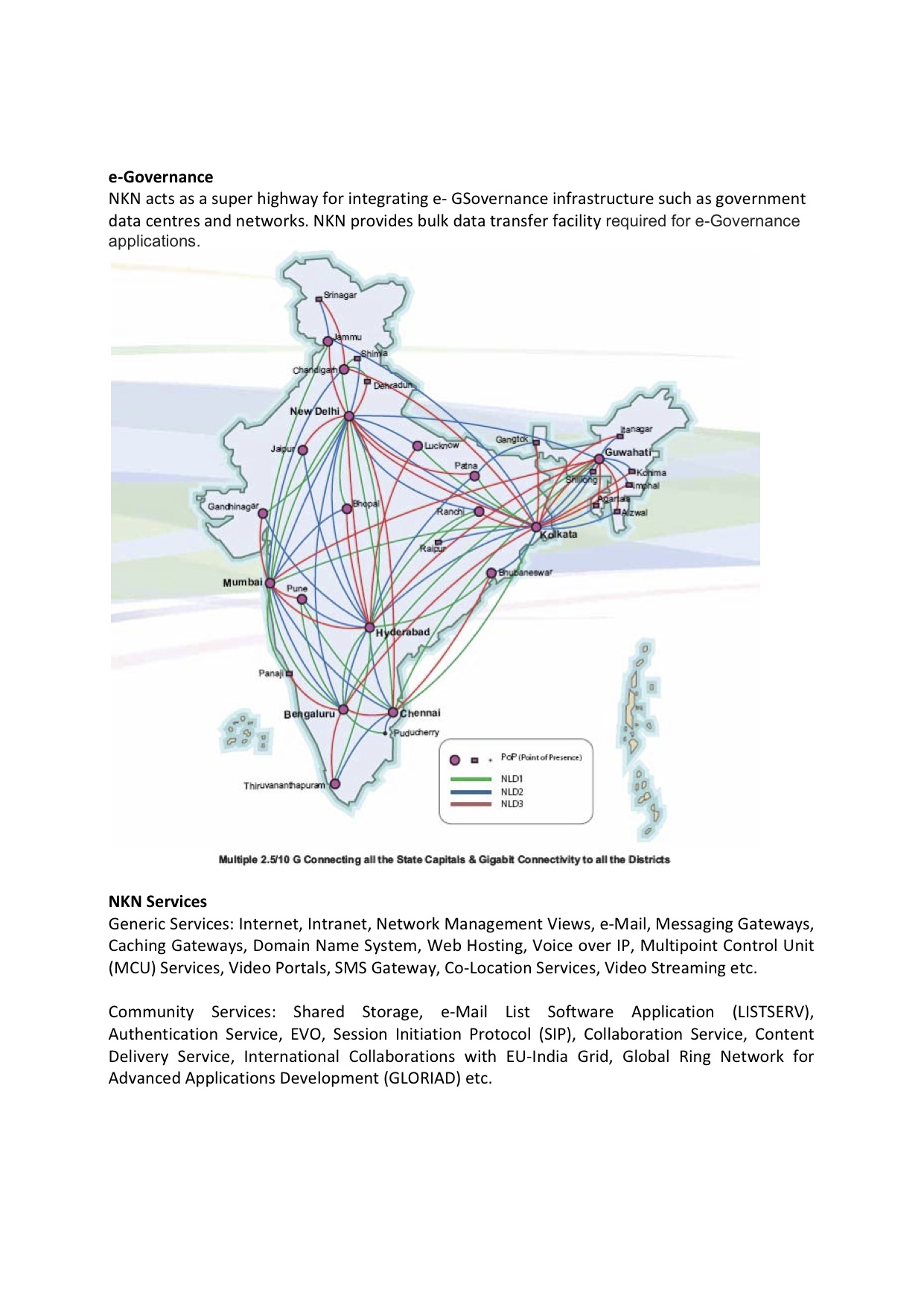
February 4th, 2011
The following table is extracted from http://www.iitg.ac.in/jee/oldinfo.php.
| Institute |
Open EE (11) |
Close EE (11) |
Open ME (24) |
Close ME (24) |
Last rank |
| IIT Bombay (B) |
1 |
98 |
56 |
471 |
4728 (B43-Chemistry) |
| IIT Delhi (D) |
76 |
252 |
249 |
603 |
2922 (D62-Biochem & Biotech) |
| IIT Madras (M) |
109 |
338 |
310 |
777 |
3898 (M64-Biotechnology) |
| IIT Kanpur (K) |
148 |
467 |
531 |
772 |
5233 (K43-Chemistry) |
| IIT Kharagpur (G) |
783 |
991 |
787 |
1156 |
8721 (G38-Architecture) |
| IIT Roorkee (R) |
612 |
1716 |
1028 |
1765 |
9490 (R38-Architecture) |
| IIT Guwahati (W) |
W16-1901 |
W-16 2338 |
1570 |
2422 |
6582 (W37-Design) |
| IIT Hyderabad (H) |
1715 |
2626 |
1920 |
2915 |
2915 (H24-Mech) |
| IIT Gandhinagar (N) |
2082 |
3007 |
2432 |
3389 |
4227 (N07-Chemical Engg) |
| IT BHU (V) |
1720 |
3285 |
2519 |
3573 |
7172 (V39-Pharma) |
| IIT Rajasthan (J) |
2765 |
3870 |
2649 |
4095 |
4095 (J24-Mech) |
| IIT Bhubaneswar (A) |
2700 |
3926 |
2683 |
4185 |
4611 (A09-Civil) |
| IIT Punjab (E) |
2976 |
3722 |
3036 |
4012 |
4012 (E24-Mech) |
| IIT Indore (U) |
2970 |
3691 |
3162 |
3925 |
3925 (U24-Mech) |
| IIT Mandi (C) |
4018 |
4496 |
3967 |
4609 |
4609 (C24-Mech) |
| IIT Patna (P) |
3343 |
4753 |
1589 |
4811 |
4811 (P24-Mech) |
| ISMU Dhanbad (S) |
4429 |
5689 |
3101 |
5624 |
7154 (S43-Chemistry)
|
February 4th, 2011
Next Posts
Previous Posts
